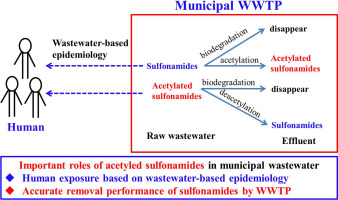Science of the Total Environment ( IF 8.2 ) Pub Date : 2018-11-01 , DOI: 10.1016/j.scitotenv.2018.10.417 Su-fen Yuan , Ze-hua Liu , Hua Yin , Zhi Dang , Ping-xiao Wu , Neng-wu Zhu , Zhang Lin

|
Antibiotics have drawn much attention as their wide usage in humans and animals may result in microbial resistance, which is a huge threat to humans' health. Studies on the occurrence and removals of antibiotics in wastewater treatment plants have been widely performed, but very few covered their main acetylated metabolites. This study developed an effective analytical method for the trace determination of four sulfonamides and three acetylated metabolites in municipal wastewaters, which was validated by linearity (R2 > 0.995), sensitivity (limit of quantification, LOQ < 0.78 ng/L), recovery (77.7%–148.1%) and precision (relative standard deviation, RSD < 9.6%). All sulfonamides and their acetylated metabolites were detected in municipal wastewaters including influent, primary settling tank and effluent. Removal performances of sulfapyridine (SP), sulfadiazine (SDZ), sulfamethoxazole (SMZ), and N4-acetyl sulfadiazine (AC-SDZ) in the municipal wastewater treatment plant were moderate or excellent, whereas the corresponding removals of sulfamethazine (SM2), N4-acetyl sulfapyridine (AC-SP), and N4-acetyl sulfamethazine (AC-SM2) were poor. The calculated poor removal of SM2 might be attributed to its fluctuation in raw wastewater, whereas the poor removals of AC-SP and AC-SM2 may be due to re-transformation from their parent sulfonamides. Our results showed that monitoring of acetylated sulfonamides in municipal wastewater is important for two reasons. One is that acetylated metabolites are good biomarkers for wastewater-based epidemiology when they are combined with their corresponding parent sulfonamides. The other is that the potential risk of sulfonamides in effluent to the natural environment cannot be accurately evaluated unless their acetylated metabolites are also accounted. This report is the first to address the potential risk of acetylated sulfonamides in effluent of wastewater treatment plants.
中文翻译:

通过SPE-LC-MS / MS对痕量磺酰胺类抗生素及其乙酰化代谢产物进行痕量测定,并从其在市政废水处理厂中的存在中得出的见解
抗生素在人类和动物中的广泛使用可能引起微生物耐药性,这引起了人们的极大关注,这对人类健康构成了巨大威胁。关于废水处理厂中抗生素的发生和清除的研究已经广泛开展,但很少涉及其主要乙酰化代谢产物。这项研究开发了一种有效的分析方法,用于痕量测定城市废水中的四种磺酰胺和三种乙酰化代谢物,并通过线性度(R 2)进行了验证。 > 0.995),灵敏度(定量极限,LOQ <0.78 ng / L),回收率(77.7%–148.1%)和精密度(相对标准偏差,RSD <9.6%)。在市政废水中(包括进水,初次沉淀池和废水)中检测到所有磺酰胺类及其乙酰化代谢产物。在市政废水处理厂中,磺胺吡啶(SP),磺胺嘧啶(SDZ),磺胺甲恶唑(SMZ)和N 4-乙酰基磺胺嘧啶(AC-SDZ)的去除性能中等或优异,而相应的磺胺二甲基嘧啶(SM2)的去除性能为N 4-乙酰基磺胺吡啶(AC-SP)和N 4-乙酰基磺胺二甲嘧啶(AC-SM2)较差。计算得出的SM2去除率不佳可能归因于其在原废水中的波动,而AC-SP和AC-SM2去除率不佳可能是由于其母体磺酰胺的再转化所致。我们的结果表明,监测市政废水中的乙酰化磺酰胺很重要,原因有两个。一种是乙酰化代谢物与相应的母体磺酰胺结合使用时,是基于废水的流行病学的良好生物标记。另一个问题是,除非也考虑了它们的乙酰化代谢物,否则无法准确评估自然环境废水中磺酰胺的潜在风险。该报告是第一个解决废水处理厂废水中乙酰化磺酰胺潜在风险的报告。













































 京公网安备 11010802027423号
京公网安备 11010802027423号